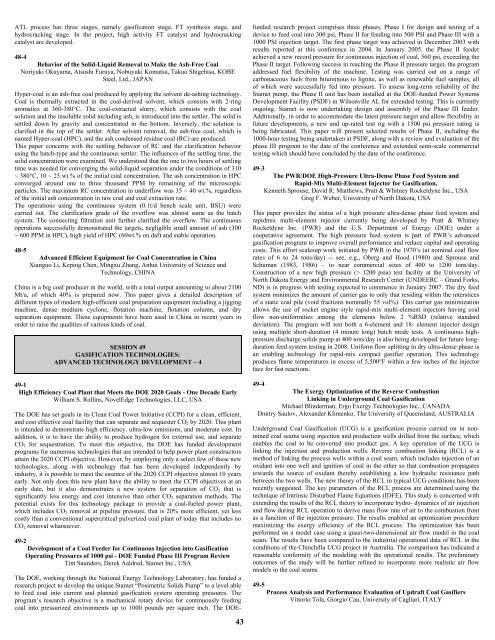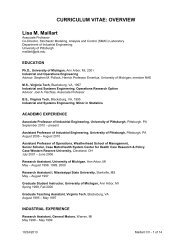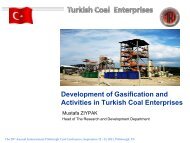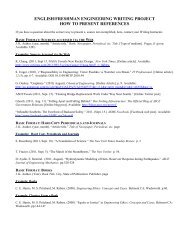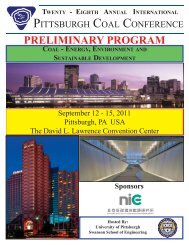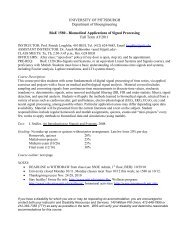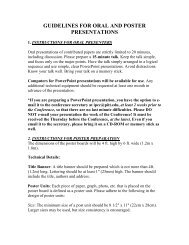Abstract Booklet 2006 - Swanson School of Engineering - University ...
Abstract Booklet 2006 - Swanson School of Engineering - University ...
Abstract Booklet 2006 - Swanson School of Engineering - University ...
Create successful ePaper yourself
Turn your PDF publications into a flip-book with our unique Google optimized e-Paper software.
ATL process has three stages, namely gasification stage, FT synthesis stage, and<br />
hydrocracking stage. In the project, high activity FT catalyst and hydrocracking<br />
catalyst are developed.<br />
48-4<br />
Behavior <strong>of</strong> the Solid-Liquid Removal to Make the Ash-Free Coal<br />
Noriyuki Okuyama, Atsushi Furuya, Nobuyuki Komatsu, Takuo Shigehisa, KOBE<br />
Steel, Ltd., JAPAN<br />
Hyper-coal is an ash-free coal produced by applying the solvent de-ashing technology.<br />
Coal is thermally extracted in the coal-derived solvent, which consists with 2-ring<br />
aromatics at 360-380°C. The coal-extracted slurry, which consists with the coal<br />
solution and the insoluble solid including ash, is introduced into the settler. The solid is<br />
settled down by gravity and concentrated in the bottom. Inversely, the solution is<br />
clarified in the top <strong>of</strong> the settler. After solvent removal, the ash-free coal, which is<br />
named Hyper-coal (HPC), and the ash condensed residue coal (RC) are produced.<br />
This paper concerns with the settling behavior <strong>of</strong> RC and the clarification behavior<br />
using the batch-type and the continuous settler. The influences <strong>of</strong> the settling time, the<br />
solid concentration were examined. We understood that the one to two hours <strong>of</strong> settling<br />
time was needed for converging the solid-liquid separation under the conditions <strong>of</strong> 310<br />
~ 380°C, 10 ~ 25 wt.% <strong>of</strong> the initial coal concentration. The ash concentration in HPC<br />
converged around one to three thousand PPM by remaining <strong>of</strong> the microscopic<br />
particles. The maximum RC concentration in underflow was 35 ~ 40 wt.%, regardless<br />
<strong>of</strong> the initial ash concentration in raw coal and coal extraction rate.<br />
The operations using the continuous system (0.1t/d bench scale unit, BSU) were<br />
carried out. The clarification grade <strong>of</strong> the overflow was almost same as the batch<br />
system. The connecting filtration unit further clarified the overflow. The continuous<br />
operations successfully demonstrated the targets, negligible small amount <strong>of</strong> ash (300<br />
~ 600 PPM in HPC), high yield <strong>of</strong> HPC (60wt.% on daf) and stable operation.<br />
48-5<br />
Advanced Efficient Equipment for Coal Concentration in China<br />
Xianguo Li, Keping Chen, Mingxu Zhang, Anhui <strong>University</strong> <strong>of</strong> Science and<br />
Technology, CHINA<br />
China is a big coal producer in the world, with a total output amounting to about 2100<br />
Mt/a, <strong>of</strong> which 40% is prepared now. This paper gives a detailed description <strong>of</strong><br />
different types <strong>of</strong> modern high-efficient coal preparation equipment including a jigging<br />
machine, dense medium cyclone, flotation machine, flotation column, and dry<br />
separation equipment. These equipments have been used in China in recent years in<br />
order to raise the qualities <strong>of</strong> various kinds <strong>of</strong> coal.<br />
SESSION 49<br />
GASIFICATION TECHNOLOGIES:<br />
ADVANCED TECHNOLOGY DEVELOPMENT – 4<br />
49-1<br />
High Efficiency Coal Plant that Meets the DOE 2020 Goals - One Decade Early<br />
William S. Rollins, NovelEdge Technologies, LLC, USA<br />
The DOE has set goals in its Clean Coal Power Initiative (CCPI) for a clean, efficient,<br />
and cost effective coal facility that can separate and sequester CO 2 by 2020. This plant<br />
is intended to demonstrate high efficiency, ultra-low emissions, and moderate cost. In<br />
addition, it is to have the ability to produce hydrogen for external use, and separate<br />
CO 2 for sequestration. To meet this objective, the DOE has funded development<br />
programs for numerous technologies that are intended to help power plant constructors<br />
attain the 2020 CCPI objective. However, by employing only a select few <strong>of</strong> these new<br />
technologies, along with technology that has been developed independently by<br />
industry, it is possible to meet the essence <strong>of</strong> the 2020 CCPI objective almost 10 years<br />
early. Not only does this new plant have the ability to meet the CCPI objectives at an<br />
early date, but it also demonstrates a new system for separation <strong>of</strong> CO 2 that is<br />
significantly less energy and cost intensive than other CO 2 separation methods. The<br />
potential exists for this technology package to provide a coal-fueled power plant,<br />
which includes CO 2 removal at pipeline pressure, that is 20% more efficient, yet less<br />
costly than a conventional supercritical pulverized coal plant <strong>of</strong> today that includes no<br />
CO 2 removal whatsoever.<br />
49-2<br />
Development <strong>of</strong> a Coal Feeder for Continuous Injection into Gasification<br />
Operating Pressures <strong>of</strong> 1000 psi - DOE Funded Phase III Program Review<br />
Tim Saunders, Derek Aaldred, Stamet Inc., USA<br />
43<br />
The DOE, working through the National Energy Technology Laboratory, has funded a<br />
research project to develop the unique Stamet “Posimetric Solids Pump” to a level able<br />
to feed coal into current and planned gasification system operating pressures. The<br />
program’s research objective is a mechanical rotary device for continuously feeding<br />
coal into pressurized environments up to 1000 pounds per square inch. The DOEfunded<br />
research project comprises three phases, Phase I for design and testing <strong>of</strong> a<br />
device to feed coal into 300 psi, Phase II for feeding into 500 PSI and Phase III with a<br />
1000 PSI injection target. The first phase target was achieved in December 2003 with<br />
results reported at this conference in 2004. In January 2005, the Phase II feeder<br />
achieved a new record pressure for continuous injection <strong>of</strong> coal, 560 psi, exceeding the<br />
Phase II target. Following success in reaching the Phase II pressure target, the program<br />
addressed fuel flexibility <strong>of</strong> the machine. Testing was carried out on a range <strong>of</strong><br />
carbonaceous fuels from bituminous to lignite, as well as renewable fuel samples, all<br />
<strong>of</strong> which were successfully fed into pressure. To assess long-term reliability <strong>of</strong> the<br />
Stamet pump, the Phase II unit has been installed at the DOE-funded Power Systems<br />
Development Facility (PSDF) in Wilsonville AL for extended testing. This is currently<br />
ongoing. Stamet is now undertaking design and assembly <strong>of</strong> the Phase III feeder.<br />
Additionally, in order to accommodate the latest pressure target and allow flexibility in<br />
future developments, a new and up-rated test rig with a 1500 psi pressure rating is<br />
being fabricated. This paper will present selected results <strong>of</strong> Phase II, including the<br />
1000-hour testing being undertaken at PSDF, along with a review and evaluation <strong>of</strong> the<br />
phase III program to the date <strong>of</strong> the conference and extended semi-scale commercial<br />
testing which should have concluded by the date <strong>of</strong> the conference.<br />
49-3<br />
The PWR/DOE High-Pressure Ultra-Dense Phase Feed System and<br />
Rapid-Mix Multi-Element Injector for Gasification,<br />
Kenneth Sprouse, David R. Matthews, Pratt & Whitney Rocketdyne Inc., USA<br />
Greg F. Weber, <strong>University</strong> <strong>of</strong> North Dakota, USA<br />
This paper provides the status <strong>of</strong> a high pressure ultra-dense phase feed system and<br />
rapidmix multi-element injector currently being developed by Pratt & Whitney<br />
Rocketdyne Inc. (PWR) and the U.S. Department <strong>of</strong> Energy (DOE) under a<br />
cooperative agreement. The high pressure feed system is part <strong>of</strong> PWR’s advanced<br />
gasification program to improve overall performance and reduce capital and operating<br />
costs. This effort scalesup work initiated by PWR in the 1970’s (at nominal coal flow<br />
rates <strong>of</strong> 6 to 24 tons/day) -- see, e.g., Oberg and Hood (1980) and Sprouse and<br />
Schuman (1983, 1986) – to near commercial sizes <strong>of</strong> 400 to 1200 tons/day.<br />
Construction <strong>of</strong> a new high pressure (> 1200 psia) test facility at the <strong>University</strong> <strong>of</strong><br />
North Dakota Energy and Environmental Research Center (UNDEERC – Grand Forks,<br />
ND) is in progress with testing expected to commence in January 2007. The dry feed<br />
system minimizes the amount <strong>of</strong> carrier gas to only that residing within the interstices<br />
<strong>of</strong> a static coal pile (void fractions nominally 55 vol%). This carrier gas minimization<br />
allows the use <strong>of</strong> rocket engine style rapid-mix multi-element injectors having coal<br />
flow non-uniformities among the elements below 2 %RSD (relative standard<br />
deviation). The program will test both a 6-element and 18- element injector design<br />
using multiple short-duration (4 minute long) batch mode tests. A continuous highpressure<br />
discharge solids pump at 400 tons/day is also being developed for future longduration<br />
feed system testing in 2008. Uniform flow splitting in dry ultra-dense phase is<br />
an enabling technology for rapid-mix compact gasifier operation. This technology<br />
produces flame temperatures in excess <strong>of</strong> 5,500°F within a few inches <strong>of</strong> the injector<br />
face for fast reactions.<br />
49-4<br />
The Exergy Optimization <strong>of</strong> the Reverse Combustion<br />
Linking in Underground Coal Gasification<br />
Michael Blinderman, Ergo Exergy Technologies Inc., CANADA<br />
Dmitry Saulov, Alexander Klimenko, The <strong>University</strong> <strong>of</strong> Queensland, AUSTRALIA<br />
Underground Coal Gasification (UCG) is a gasification process carried on in nonmined<br />
coal seams using injection and production wells drilled from the surface, which<br />
enables the coal to be converted into product gas. A key operation <strong>of</strong> the UCG is<br />
linking the injection and production wells. Reverse combustion linking (RCL) is a<br />
method <strong>of</strong> linking the process wells within a coal seam, which includes injection <strong>of</strong> an<br />
oxidant into one well and ignition <strong>of</strong> coal in the other so that combustion propagates<br />
towards the source <strong>of</strong> oxidant thereby establishing a low hydraulic resistance path<br />
between the two wells. The new theory <strong>of</strong> the RCL in typical UCG conditions has been<br />
recently suggested. The key parameters <strong>of</strong> the RCL process are determined using the<br />
technique <strong>of</strong> Intrinsic Disturbed Flame Equations (IDFE). This study is concerned with<br />
extending the results <strong>of</strong> the RCL theory to incorporate hydro- dynamics <strong>of</strong> air injection<br />
and flow during RCL operation to derive mass flow rate <strong>of</strong> air to the combustion front<br />
as a function <strong>of</strong> the injection pressure. The results enabled an optimization procedure<br />
maximizing the exergy efficiency <strong>of</strong> the RCL process. The optimization has been<br />
performed on a model case using a quasi-two-dimensional air flow model in the coal<br />
seam. The results have been compared to the industrial operational data <strong>of</strong> RCL in the<br />
conditions <strong>of</strong> the Chinchilla UCG project in Australia. The comparison has indicated a<br />
reasonable conformity <strong>of</strong> the modeling with the operational results. The preliminary<br />
outcomes <strong>of</strong> the study will be further refined to incorporate more realistic air flow<br />
models in the coal seams.<br />
49-5<br />
Process Analysis and Performance Evaluation <strong>of</strong> Updraft Coal Gasifiers<br />
Vittorio Tola, Giorgio Cau, <strong>University</strong> <strong>of</strong> Cagliari, ITALY


